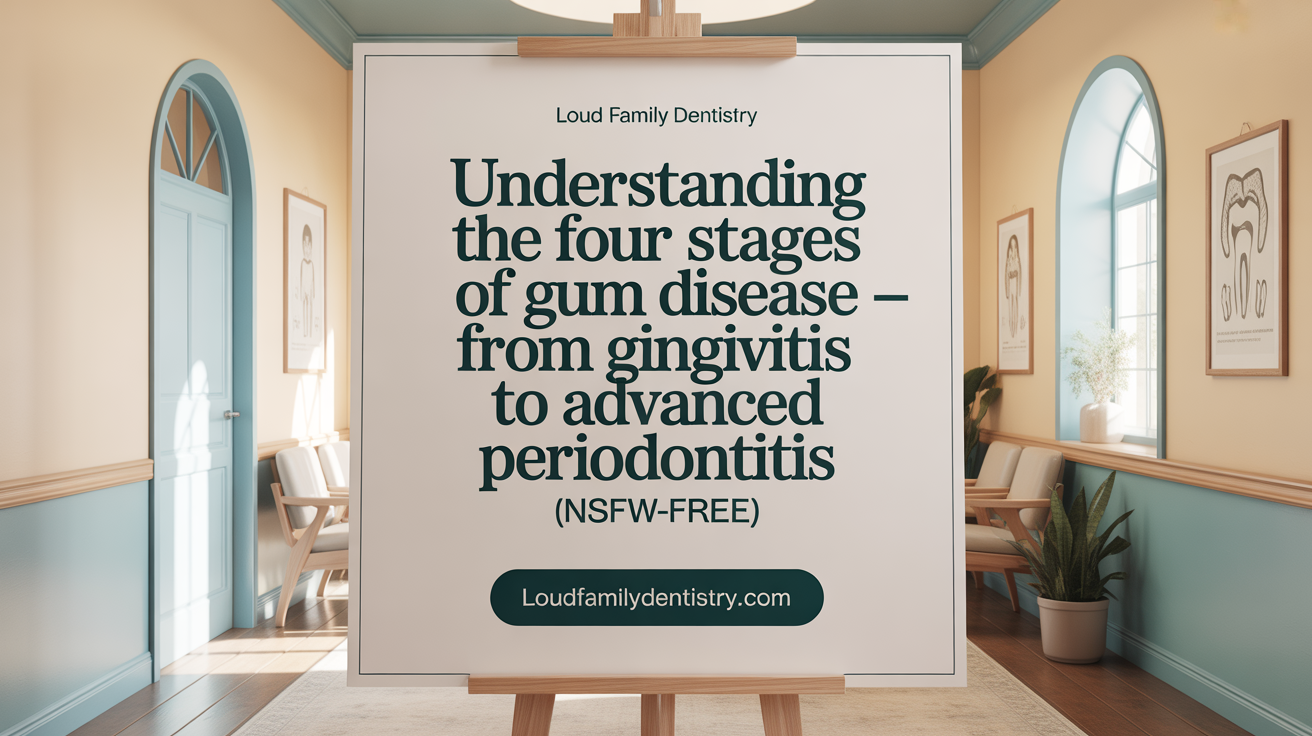Why Understanding Gum Disease Matters
Gum disease, or periodontal disease, affects nearly half of adults over 30 and is a leading cause of tooth loss worldwide. Despite its prevalence, many people remain unaware of its progression, symptoms, and the crucial importance of early intervention. This article explores the stages of gum disease, signs to watch for, diagnostic methods, treatment options, and preventive strategies to empower readers in maintaining healthy gums and teeth.
The Four Stages of Gum Disease: From Gingivitis to Advanced Periodontitis

What are the stages of gum disease and their definitions?
Gum disease develops through a series of stages, starting with gingivitis, then progressing to periodontitis at various levels of severity. The first stage, gingivitis, involves inflammation of the gums, evidenced by redness, swelling, bleeding during brushing or flossing, and sensitivity. This initial phase is reversible through improved oral hygiene and professional treatment.
If untreated, gingivitis can advance into early periodontitis. In this stage, the infection penetrates deeper, affecting the supporting bone, and leads to gum recession, the formation of periodontal pockets, and slight bone loss. The disease then moves into moderate or in-between stages, where there is further loss of tissue and bone structure.
Subsequently, the disease reaches advanced periodontitis, characterized by significant bone destruction, tooth mobility, and potential tooth loss. This stage includes deep periodontal pockets exceeding 7 millimeters, extensive gum recession, and worsening tissue damage.
The 2017 classification further details periodontitis into stages based on severity (Stage I to IV) considering factors such as bone loss, pocket depths, and complexity of treatment needed. The progression underscores the importance of early detection and intervention to prevent irreversible damage.
What are the differences between gingivitis and periodontitis?
Gingivitis is the earliest form of gum disease, limited strictly to the gums. It is marked by redness, swelling, tenderness, and bleeding, especially during oral hygiene procedures. Importantly, there is no loss of bone or tissue support at this stage, making gingivitis fully reversible with proper dental care.
In contrast, periodontitis signifies a more severe and advanced condition where the bacterial infection spreads below the gum line. This leads to destruction of the supporting structures of the teeth, including the ligaments and jawbone. Symptoms of periodontitis include deep periodontal pockets, receding gums, loose teeth, and even abscesses.
While gingivitis results purely from plaque-related inflammation, periodontitis involves irreversible tissue and bone loss. If left untreated, periodontitis can lead to tooth mobility and eventual tooth loss. Therefore, distinguishing between these stages is critical for effective treatment and prognosis.
How does gum disease progress?
Gum disease begins with plaque buildup on the teeth. If not removed through regular brushing and flossing, plaque hardens into tartar, harboring bacteria that irritate the gums. This inflammation initially manifests as gingivitis.
Over time, the bacteria and immune response cause deeper inflammation, leading to destruction of the supporting bone and tissues—the transition from gingivitis to periodontitis. As the disease advances, pockets deepen, and bone loss increases, which can ultimately result in loose or lost teeth.
The progression from minor gum inflammation to severe periodontitis underscores the importance of preventive oral hygiene and regular dental checkups. Early stages are reversible, but advanced damage demands more complex interventions, including surgical procedures.
Recognizing Symptoms and Signs Across Each Stage
 Gum disease progresses through several stages, each with distinct symptoms and visible signs. Recognizing these early cues is crucial for prompt management and prevention of severe outcomes.
Gum disease progresses through several stages, each with distinct symptoms and visible signs. Recognizing these early cues is crucial for prompt management and prevention of severe outcomes.
In the initial stage, gingivitis, common symptoms include red, swollen gums that bleed easily during brushing or flossing. At this point, the infection is limited to the gum tissue and is reversible through improved oral hygiene and professional cleaning.
As the disease advances into early periodontitis, signs become more pronounced. The gums may recede slightly, forming pockets around the teeth, which can harbor bacteria. Symptoms here include persistent bad breath, increased gum bleeding, swelling, redness, or tenderness, along with potential tooth sensitivity due to exposed roots. Bone support begins to deteriorate, but the damage is still reversible with treatment.
Moderate periodontitis is marked by deeper periodontal pockets, often exceeding 6 millimeters, with increased tissue destruction. Signs include more evident gum recession, loose teeth, and discomfort while chewing. Pus might be visible in severe cases, and there could be noticeable bone loss on radiographs. Symptoms such as abscess formation and changes in bite position are common.
In advanced stages, the destruction becomes severe. Indicators include significant gum recession, tooth mobility, shifting teeth, and even tooth loss. Patients often experience severe pain and discomfort, swelling, and pus drainage from abscesses. The supporting bone has been heavily compromised, leading to marked facial changes and the potential need for surgical intervention.
Understanding the varying severity across these stages enables early diagnosis and timely treatment. Regular dental checkups allow for the detection of subtle signs like gum redness or slight bleeding before they develop into more serious issues. Prompt action at each stage can save teeth and preserve gum health, preventing irreversible damage.
Diagnosing Gum Disease and Assessing Its Progression
 Gum disease diagnosis involves a careful combination of clinical examinations, measurements, and imaging techniques.
Gum disease diagnosis involves a careful combination of clinical examinations, measurements, and imaging techniques.
Dentists start by visually inspecting your gums for signs such as redness, swelling, and bleeding. They also check for gum recession, pus, and the stability of your teeth.
One of the primary tools used is periodontal probing. During this procedure, a dental probe is gently inserted between the tooth and gum to measure the depth of the gum pockets. Healthy gums typically have pocket depths of 0 to 3 millimeters. If the measurement is 4 millimeters or more, it suggests the presence of gum disease.
Higher pocket depths indicate more advanced stages. For example, pocket depths of 6-7 millimeters often align with moderate periodontitis, where there is significant tissue and bone loss.
Dental X-rays are also essential for evaluating bone health. These images reveal the extent of bone loss and help distinguish between the different stages of gum disease. Decreased bone support around teeth indicates progression from gingivitis to periodontitis.
Stages of gum disease are classified based on pocket depth, bone destruction, and tissue damage. Gingivitis involves no bone loss and reversible inflammation. Early periodontitis shows initial bone loss with pockets generally measuring 4-5 millimeters. Moderate periodontitis features deeper pockets of 6-7 millimeters and more substantial bone loss. Advanced periodontitis presents with deep pockets over 7 millimeters, severe bone destruction, and often tooth mobility.
Accurate diagnosis is crucial for planning appropriate treatment, which ranges from improved oral hygiene and professional cleaning in early stages to surgical procedures in advanced cases. Regular dental checkups with periodontal probing and X-rays enable early detection, helping preserve your oral health.
Tailored Treatment Strategies for Each Stage of Gum Disease

What treatment options are available for each stage of gum disease?
Treatment strategies for gum disease depend heavily on its severity. In the earliest stage, gingivitis, the main approach is to remove plaque and tartar buildup through professional cleanings such as scaling and polishing. Improved daily oral hygiene, including brushing twice a day and flossing, typically suffices to reverse gingivitis.
As the disease progresses to early periodontitis, treatment becomes more involved. Scaling and root planing are common procedures to clean below the gum line, removing bacteria and smoothing root surfaces to promote healing. Sometimes, antibiotics or antimicrobial mouthwashes are prescribed to control bacterial growth.
Moderate gum disease often involves deeper periodontal pockets and more significant bone loss. In addition to scaling and root planing, surgical options such as flap surgery to access and clean deeper pockets or regenerative procedures like guided tissue regeneration may be necessary to restore lost tissue.
In advanced stages, termed Stage 4 or severe periodontitis, extensive interventions are required. These can include advanced periodontal surgery, bone grafting, soft tissue grafts, or even surgical removal of severely damaged tissue. When teeth are loose or severely affected, extraction and replacement options such as implants or dentures might be recommended.
Throughout all stages, continuous maintenance through professional cleanings and good oral hygiene practices are vital to control the disease.
Nonsurgical procedures
Nonsurgical treatments are primarily aimed at plaque and tartar removal and include procedures like scaling, root planing, and antimicrobial treatments. These are usually sufficient in gingivitis and early periodontitis.
Surgical interventions
When nonsurgical methods are not enough, surgical procedures come into play. These include flap surgery, bone and tissue grafts, guided tissue regeneration, and laser therapy aimed at reducing pocket depths, regenerating lost tissue, and restoring the supportive structures of the teeth.
Importance of oral hygiene and professional care
Consistent daily brushing, flossing, and routine dental visits are critical in preventing the worsening of gum disease. Professional care helps catch early signs of inflammation and progress, ensuring timely and appropriate treatment to preserve oral and overall health.
The Critical Role of Early Detection and Prevention

Why is early detection and intervention important in managing gum disease?
Detecting gum disease at an early stage is crucial because it allows for simpler, more effective treatment options, often preventing irreversible damage. Gingivitis, the initial, reversible phase, typically shows symptoms like swollen, bleeding gums, and can be managed with improved oral hygiene and professional cleaning.
If untreated, gingivitis can advance into early periodontitis, where bacteria invade deeper into the supporting bone, leading to periodontal pockets and bone loss. At this stage, symptoms such as persistent bad breath, receding gums, and loose teeth begin to appear. Once the disease progresses further into moderate and advanced stages, the destruction of bone and tissue becomes permanent, often resulting in tooth mobility or loss.
Early intervention not only preserves natural teeth but also reduces the need for invasive procedures like surgery. Timely treatment minimizes overall dental costs and discomfort. Moreover, managing gum disease early helps prevent systemic health issues. Studies show links between periodontal infections and conditions such as heart disease, stroke, and diabetes, making early detection critical for broader health benefits.
Regular dental checkups, periodontal screenings, and awareness of early symptoms are essential strategies in catching gum disease early. With prompt care, it is possible to halt progression, protect oral health, and support overall well-being.
How serious is each stage of gum disease and what risks do they pose?
Gum disease severity increases with each stage. Stage 1, or gingivitis, involves mild inflammation, redness, and bleeding but does not cause bone loss. It's reversible, with proper oral hygiene. However, if neglected, it can develop into early periodontitis, where bacteria begin to break down supporting bone, leading to pockets of 4-5 mm and symptoms like bad breath and gum recession.
Progressing further, Stage 3, moderate periodontitis, features deeper pockets exceeding 6 mm, notable bone loss, and potential tooth mobility. Bacteria reaching the bloodstream increases risks for systemic health problems.
In the most severe stage, advanced periodontitis, there is extensive tissue and bone destruction, pus formation, severe pain, and tooth loss. This stage often requires surgical intervention. Overall, untreated gum disease can cause significant structural damage to teeth and supporting tissues, with wider health implications including increased risks of cardiovascular disease and diabetes.
What preventive measures and lifestyle factors influence gum health?
Preventing gum disease relies mainly on maintaining excellent oral hygiene. Regular brushing twice a day with fluoride toothpaste, daily flossing, and professional dental cleanings help remove plaque before it hardens into tartar. Avoiding tobacco use, which significantly increases risk, is also vital.
Healthy lifestyle choices further support gum health. A balanced diet rich in vitamins and minerals boosts the immune system. Managing systemic health conditions like diabetes can reduce susceptibility to infections.
Reducing stress is beneficial because high stress levels weaken immune responses, making gums more prone to infections. Limiting alcohol consumption and avoiding clenching or grinding teeth also contribute positively.
Early treatment of any symptoms, combined with consistent dental visits, maximizes prevention efforts. Educating oneself about early signs, such as bleeding or receding gums, facilitates prompt action.
What are the overall health implications of gum disease?
While gum disease is primarily a dental concern, its impact extends beyond the mouth. Chronic inflammation associated with periodontal disease has been linked to cardiovascular issues, including increased risk of heart attack and stroke.
In people with diabetes, gum disease can make blood sugar management more difficult, worsening overall health. During pregnancy, untreated gum infections are associated with preterm birth and low birth weight.
Bacteria from infected gums can enter the bloodstream, potentially causing infections elsewhere. Therefore, managing periodontal health is not only about preserving teeth but also about maintaining systemic health.
Understanding the stages and adopting preventive habits significantly reduces these risks, emphasizing the importance of regular dental care and early detection.
Protecting Your Smile Through Awareness and Action
Understanding the stages of gum disease empowers individuals to recognize early symptoms and seek timely professional care. Gingivitis, the initial and reversible phase, highlights the body's response to bacterial plaque buildup and can be effectively managed with proper oral hygiene and regular dental visits. If neglected, the condition may progress into periodontitis, resulting in irreversible damage to the supporting structures of teeth, increased risk of tooth loss, and potential impacts on overall systemic health. Through early diagnosis, tailored treatment plans, and vigilant preventive measures—including lifestyle modifications such as quitting smoking and managing chronic diseases—gum disease can be controlled or even prevented. Prioritizing oral health and ongoing communication with dental professionals are key steps toward maintaining a healthy, confident smile for life.
References
- Periodontal Disease (Gum Disease): Causes, Symptoms & Treatment
- Gum disease stages, causes and treatments - Northwell Health
- Understanding the Stages of Gum Disease and Why Choose ...
- The Four Stages of Gum Disease
- Periodontal Disease: Understanding the Stages and Signs
- What Are The Stages Of Gum Disease? | Colgate
- The Stages of Gum Disease | Tampa, FL, Dentist
